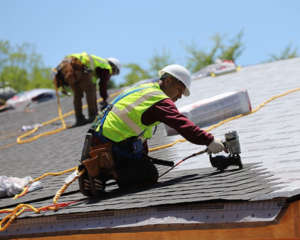A roof is the top covering of a building that protects it from rain, snow, sunlight, extreme temperatures and wind. People who specialize in roofing are called roofers.
A roof can have a flat or sloped surface. A roof with a steep slope is said to have a high pitch or a steep roof.

The type of roofing material used on your home has a significant impact on its appearance, durability and longevity. Choosing the right roofing materials depends on your home’s location, your aesthetic preferences and your budget. The most popular choice for residential roofs is asphalt shingles, but there are several other options available, from clay tiles to synthetic roofing materials.
Wood is another popular roofing material. It’s especially attractive on Cape Cod-style homes and in other coastal areas, but it’s not well suited to dry climates and is a fire hazard. It’s also expensive and a poor choice for high-wind areas.
Metal is another durable roofing material that comes in many shapes and colors, making it a good fit for many different architectural styles. It’s also energy efficient, reducing your monthly power bills. One of the downsides is that it can be noisy in windy weather.
Rolled roofing, or tar and gravel, is an inexpensive option for low-slope roofs. It consists of long rolls of mineral-impregnated and asphalt-covered materials topped with granules. This roofing doesn’t offer much in terms of visual appeal, but it’s a good choice for utilitarian outbuildings like sheds and garages.
Rubber is another common roofing material that’s often found on commercial buildings. It can be produced in a wide range of colors and offers a long lifespan, but it doesn’t have the natural insulating properties of other roofing materials.
Synthetic shingles are a newer roofing material that’s becoming increasingly popular with homeowners. Made from recycled materials and an engineered polymer, they’re designed to mimic the look of other roofing materials, including cedar shake shingles and slate tiles. They offer a high impact rating and come in a variety of colors.
BUR, or built-up roofing, is a popular choice for flat and low-slope roofs. It’s a composite material composed of layers of asphalt and reinforcing felt, known as ply sheets. BUR roofing is highly water-resistant, withstands heavy foot traffic and has a Class A fire rating. It can also be coated with a reflective surface, improving your home’s energy efficiency.
Roofing Installation
The roof is the top covering of a building that protects against rain, snow, sunlight, wind, and extreme temperatures. It can be constructed in a wide variety of forms, including flat, pitched, vaulted, domed, and other designs dictated by technical, economic, or aesthetic considerations.
The roofing installation process begins with removing any existing shingles and flashing. The roof deck is then inspected to ensure it is in good condition and capable of supporting the new roofing materials. If necessary, the roof deck is reinforced or replaced.
Roofers then begin to lay the new shingles. They start at the eaves and work their way up, overlapping each row by six inches and nailing them in place with a pattern that alternates between close nails near the edges and nails further apart towards the center of the roof. A vapor retarder may be installed at this point as well, depending on the roofing material chosen.
After the new shingles are in place, caulking is applied to the raw edges of each shingle and metal flashing is put around chimneys, skylights, and vents to prevent water leakage in these vulnerable areas. Then, the tarps are removed and debris is hauled away, usually to special construction dumps that handle different types of roofing materials.
Roofing Repair
The roof protects the structure and its inhabitants from rain, snow, sunlight, extreme temperatures, tree branches and other forces. Sometimes these forces cause damage that requires roofing repair. The repair process depends on the severity of the damage. Repairs can range from repairing a small leak to replacing an entire roof.
The first step in the repair process is to find the source of the problem. This is typically done by following a trail of water damage (stained ceiling) or deteriorating insulation to the source. The roofer will then use several technologies to map the wet area and locate leak locations.
Flashing is thin sheet metal that’s bent around parts of the roof, such as pipes. To repair it, the roofer will usually need to remove the old flashing, re-bend it and reseal it. This can be difficult, especially if the flashing was fixed to the roof with nails instead of sealant.
Depending on the type of roofing, flashing may also be sealed with sealant or roofing cement. The roofer will also need to replace any damaged shingles or tiles. Other repairs, such as sagging or improving ventilation, will take longer and may require structural work. This is when a professional will be necessary, to ensure the safety of the occupants.
Roofing Maintenance
Residential roofs are susceptible to a wide variety of problems, ranging from leaks that lead to water damage inside the home to clogged gutters that allow water to pool and damage the roofing structure. BM Roofing regularly inspects residential roofs and provides routine maintenance services to keep small problems from escalating into major ones. For example, a common cause of roof leaks is damaged or missing shingles that can be easily addressed by replacing them with new shingles. Also, it’s important to keep tree limbs from hanging too close to the house and to trim them after heavy storms or natural disasters. These simple steps can save homeowners from costly repair bills in the future. A roofing maintenance checklist should be customized for each roof.